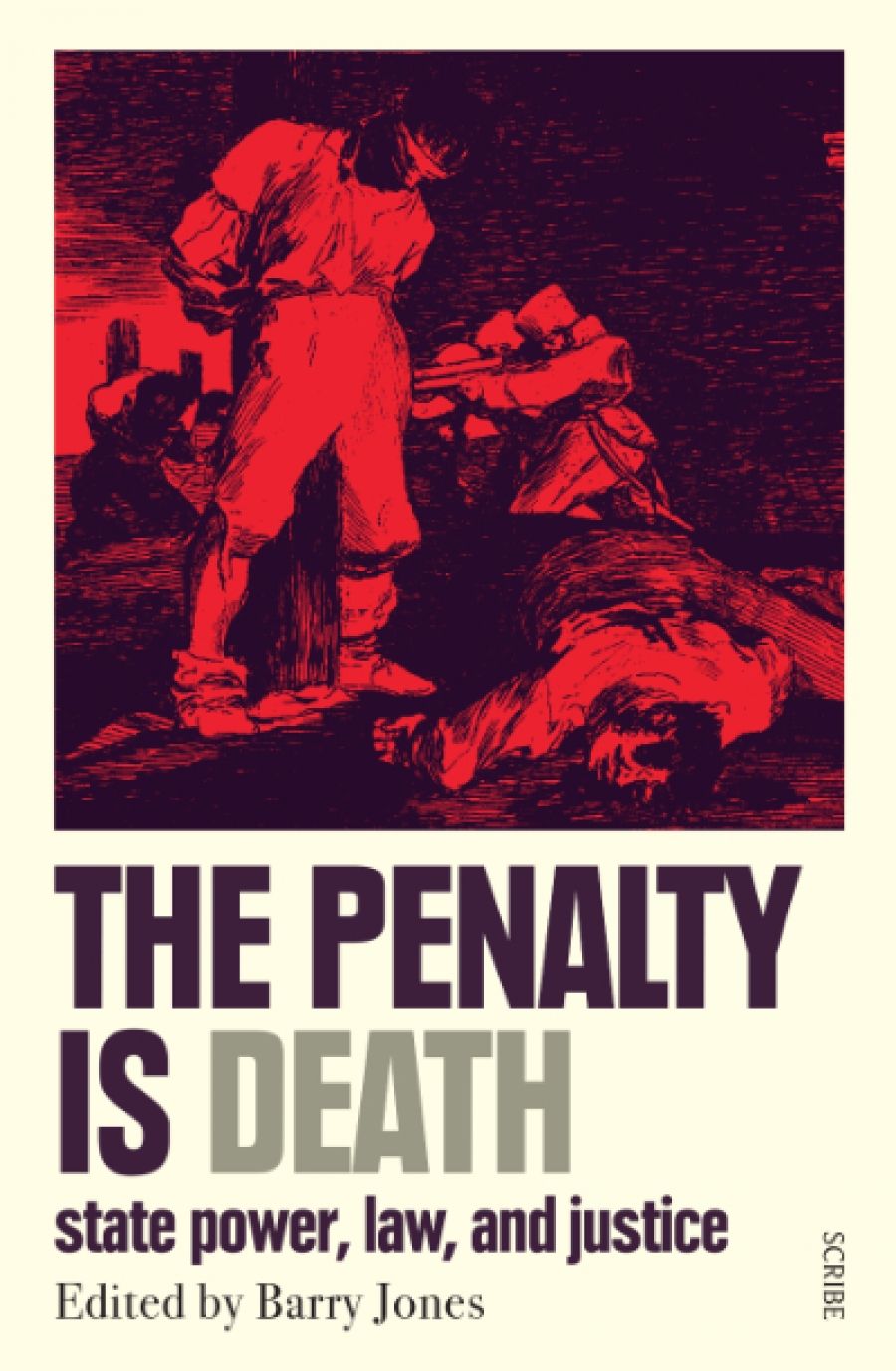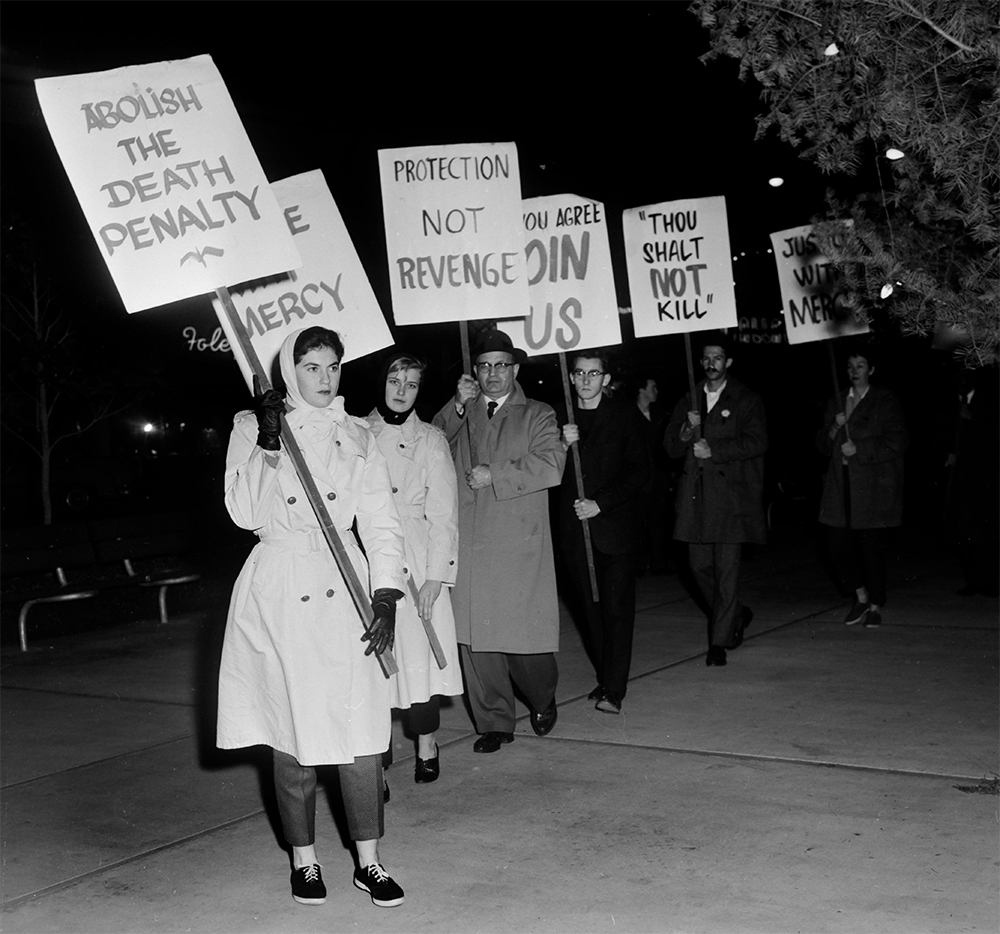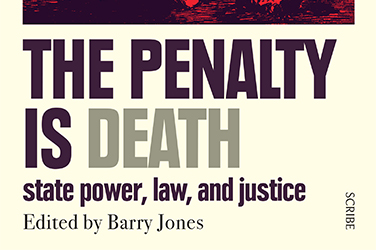
- Free Article: No
- Contents Category: Society
- Review Article: Yes
- Article Title: The fight for abolition
- Article Subtitle: A new edition of the 1968 work
- Online Only: No
- Custom Highlight Text:
In 1968, Barry Jones edited, and contributed to, the first edition of The Penalty Is Death. The book was produced in the immediate aftermath of the execution of Ronald Ryan in Victoria in February 1967, and in the context of vigorous debates in Australia and other Western countries as to the retention of the death penalty. The second edition, published to commemorate the hundredth anniversary of the abolition of the death penalty in Queensland, arrives in a very different world. A majority of countries are now either abolitionist in law, or have in place an express or de facto moratorium against execution.
- Article Hero Image (920px wide):

- Article Hero Image Caption: A protest over the death penalty in California, 1960 (photograph via Kirn Vintage/Alamy)
- Alt Tag (Article Hero Image): A protest over the death penalty in California, 1960 (photograph via Kirn Vintage/Alamy)
- Featured Image (400px * 250px):

- Alt Tag (Featured Image): Christopher Ward reviews 'The Penalty Is Death: State power, law, and justice' edited by Barry Jones
- Book 1 Title: The Penalty Is Death
- Book 1 Subtitle: State power, law, and justice
- Book 1 Biblio: Scribe, $35 pb, 345 pp
- Book 1 Readings Link: booktopia.kh4ffx.net/doB4EM
Yet the practice of judicially sanctioned killing continues unabated in many countries, sometimes on an unimaginable scale. In places in which a moratorium exists, respite is often fragile and short-lived. Even in abolitionist countries, including Australia, fringe political voices continue to ride a tidal wave of public anger in cases of horrific crimes. The publication of the second edition of this important book is of great significance, ensuring that its collection of essays and research is heard again by a new generation.
The Penalty Is Death draws upon historical essays, thoughtful philosophy, witness accounts, and statistical research to describe the overwhelming futility, administrative pettiness, and utter inhumanity of the practice of capital punishment. It does so by collecting in separate parts the writings of abolitionists, retentionists, and witnesses. It ultimately places all in a moral and practical framework that leads only to the proper conclusion that the death penalty serves no individual nor any societal interests, but rather diminishes all who are involved in its imposition, judicial imprimatur, and ultimate execution. It is a blight upon societies that continue to support or tolerate its existence.
It is extremely difficult to understand the modern scale of the death penalty. The World Coalition Against the Death Penalty has reported at least 2,397 executions in 2021. It is estimated that more than 33,000 people are currently under sentence of death worldwide. As Jones describes in an overview to the book, per capita death rates vary wildly. Although China leads the overall number of reported executions (with more than 2,000 executions recorded in 2021), its recorded per capita death rate is lower than Iran’s. In that far less populous country there were at least 365 executions in 2021. Other states with extremely high execution rates include Egypt, Saudi Arabia, and Vietnam. Liberal democracies now rarely deploy the death penalty, with the United States and, to a lesser extent, Japan, as outliers.
In the United States, it remains to be seen whether President Joe Biden makes any permanent changes to the availability of capital punishment in federal cases. Meanwhile, increasing numbers of states in that country are moving towards abolition or at least a moratorium position. As Jones explains, in the United States the death penalty has now been abolished in twenty-three states. Although it is retained in twenty-seven states, there is a moratorium in force in California, Ohio, Oregon, and Pennsylvania. Speaking with his indomitable wit, Jones wryly comments that, despite the religious fundamentalism which underpins much of the death penalty discourse in the southern states of the United States, ‘it is hard to see Jesus, a victim of execution himself, as a hard line retentionist’.
It is in the juxtaposition of the three parts of the book that its power lies. By collating essays written from an abolitionist perspective, including some from historical times, with essays written by retentionists, and concluding with eyewitness accounts of executions, the transparency, fragility, and inhumanity of arguments said to support capital punishment are exposed. That the death penalty also deeply affects those involved in its bureaucratic administration should not be doubted. It is a recurring theme of the book that the application of the death penalty in a society diminishes us all.
Barry Jones quotes Leo Tolstoy in a powerful exposition:
I understand that under the influence of momentary irritation, hatred, revenge, or loss of consciousness of his humanity, a man may kill another in his own defence or defence of a friend … But that men in full control of their human attributes can quietly and deliberately admit the necessity of killing a fellow man, and oblige others to perform that action so contrary to human nature, I never can understand.
The abolitionist arguments include, among others, essays and extracts written by Cesare Beccaria (1764), Sir Samuel Romilly MP (1810), Charles Dickens (1846), Clarence Darrow (1924), Sir Eugene Gorman (1966), and powerful prefaces by Michael Kirby, Julian McMahon, and Richard Bourke.
The concepts of deterrence and revenge are dissected with clinical precision by the authors. The death penalty is often described as a punishment uniquely able to deter acts of lethal violence. It is described as a punishment fitting the crime. As is made clear in The Penalty Is Death, statistics demonstrate the fallacy of the former; rates of murder do not increase in abolitionist states. As to the second proposition, punishments of physical brutality, an eye for an eye, once commonplace, are now rightly abandoned. They breach uniformly accepted international laws protecting human rights. Arguments for death based upon vengeance and revenge have no place in our modern world. A state that engages in sanctioned killing is not a state that is compassionate, nor is it one which discourages societal violence. As Sir John Romilly said in 1810:
I call on you to remember, that cruel punishments have an inevitable tendency to produce cruelty in the people. It is not by the destruction of tenderness, it is not by the exciting of revenge, that we can hope to generate virtuous conduct in those who are confided to our care.
Until recently, many countries in Asia maintained the death penalty in cases of narcotic trafficking. Those countries are rapidly decreasing in number, as the weight of international society turns against them. Widely ratified international treaties only permit the application of the death penalty, if at all, for the most serious crimes, which characterisation does not extend to trafficking in narcotics. The practice of Singapore must be given particular attention, executing as it does large numbers of low-scale drug traffickers, almost always from poor socio-economic and migrant backgrounds. Its courts interpret laws in such a manner as to render almost irrelevant the tenuous possible pathways to escape mandatory capital punishment.
The imposition of mandatory death sentences for trafficking in narcotics is an appalling indictment upon a modern society. As Jones says: ‘One of the sickening aspects of execution for drug offences is that only mules are caught. Those who control the drug syndicates just read about the executions on Facebook.’
The abolition of death as a sanction for trafficking in narcotics is a global priority. The Philippines, which recently, and unsuccessfully, attempted to reintroduce capital punishment for a range of crimes, including trafficking in narcotics, instead resorted to extrajudicial killings, a practice which led to systematic breakdown of law and order, and the violation of human rights on such a scale as to potentially amount to crimes against humanity. The Philippines is now under investigation by the International Criminal Court. In other places, LGBTQ people continue, extraordinarily, to face the death penalty.
In such countries, dedicated human rights advocates and brave attorneys continue to speak out in their countries and within and outside their courts against the application of the death penalty, sometimes at great personal risk. The cases manifestly fail to meet minimum standards of international law. They lead to repeated tragedies at dawn and immeasurable suffering to those families caught in the brutal, state-sanctioned processes.
It is the banal nature of the bureaucracy surrounding the death penalty, and the entirely surreal nature of litigation upon which a life is balanced, that is one of the most powerful arguments for abolition. No one who has ever participated in capital litigation can be left in any doubt as to the arbitrary nature of its application, nor the reality that all capital punishment is ultimately political. The prerogative of mercy is rarely exercised by those empowered to do so; politics looms large in those decisions.
History, as The Penalty Is Death makes clear, shows that it is in the political space that the fight for abolition must be won. However, pressure created by litigation, diplomacy, media accounts of the executions, and public awareness all have significant roles to play. As McMahon writes in the preface: ‘Those engaged in this debate know that perseverance is required.’
The publication of the second edition of The Penalty Is Death is an important step in ensuring that the fight for abolition continues, with perseverance and public support.


Comments powered by CComment